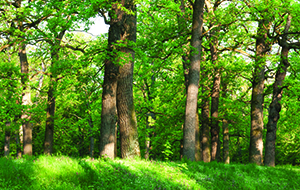Toby Turpin on Reviewing Your Plan
 When longtime Tree Farmer Toby Turpin began keeping a forest
management plan, he did it for the taxman.
When longtime Tree Farmer Toby Turpin began keeping a forest
management plan, he did it for the taxman.
“My original motivation was being cheap,” he quips. “It meant that the county would assess my property taxes at the farm rate, which would save me a whole lot of money.”
But 40 years later, Turpin is reaping the rewards of routinely reviewing his management plan. His Maryland woods have provided profitable harvests, preserved valuable historic and geological sites, and withstood natural disasters—all thanks to a detailed, up-to-date plan.
“It turns out the county did me a great favor,” he says. “The horrible-looking land I bought in the 1970s came to have beautiful trees because of that plan.”
Whether you’re a veteran Tree Farmer or a new woodland owner, now is the time to take stock of the past and plan for the future. Taking time to reflect on what’s happened during the year, how your woods were affected and how your goals have changed can bring new focus and real rewards, says Sarah Crow, certification manager for the American Tree Farm System®.
“Your management plan is basically the road map for your Tree Farm,” Crow says. “So taking time to review it helps you identify your objectives and make sure you’re still taking steps to achieve them.”
For a woodland owner who is new to forest management plans, a good first step may be starting a plan or evaluating whether your existing plan meets your needs. A consulting forester can help with these initial steps, as can MyLandPlan.org, the American Forest Foundation’s step-by-step online guide to planning for your property. Your plan should note:
- The locations of any special sites
- The plants and wildlife found in your woods
- Any invasive, threatened or endangered species.
- Receipts, copies of permits and other documentation of your forest management activities should also be included
- Maps and a list of any activities—everything from road repairs to harvests—planned for the coming year.
If you already have a detailed plan in place, reviewing it can be as simple as answering these basic questions:
- Are your trees healthy?
- Is your forest progressing as you hoped?
- Have freezes, floods or other natural disasters affected your property?
- Has your family experienced a major change, such as an illness or financial loss, that may increase your need for income from your woods?
- Are there management activities—such as prescribed burns or thinning—you’ve done or would like to do?
Together, these questions reveal how your Tree Farm is doing and what changes may be needed to adapt to new circumstances in your life or the life of your forest. They offer a roadmap to new goals and plans for your property—and some more tangible benefits as well.
An up-to-date plan can provide useful accounting information at tax time, and proof that your Tree Farm is a business if you’re claiming a profit or loss. If it includes a detailed inventory of what’s mature and ready for harvest, your plan can also enable you to take advantage of upticks in the timber market and other unforeseen opportunities. Turpin notes that his plan has aided his efforts with consulting foresters and other contractors working on his property.
“As the property owner, it’s my obligation to tell them where my property lines are, where my water bodies are, where my roads are,” Turpin says. “If I don’t want someone cutting timber around the mouth of my caves, I need to be able to tell you were the caves are.”
But the greatest reward of making and reviewing his management plan, Turpin says, is the ability to share his Tree Farm’s legacy with others.
“Some people put together picture albums of their kids—I keep a picture album of my Tree Farm,” he says. “I have a detailed diary of what I’ve been doing on my Tree Farm for the past 50 years because of my forest management plan.”


